Pretty terrible stuff. :\
http://www.bbc.co.uk/news/world-europe-23442018" onclick="window.open(this.href);return false;
http://www.bbc.co.uk/news/world-europe-23442018" onclick="window.open(this.href);return false;
All 13 carriages of the train, which was travelling from Madrid to Ferrol, came off the tracks near the city of Santiago de Compostela.
Images from the scene showed bodies strewn near ruined carriages, and emergency crews searching the wreckage.
Next stop the square, journal square station next!

